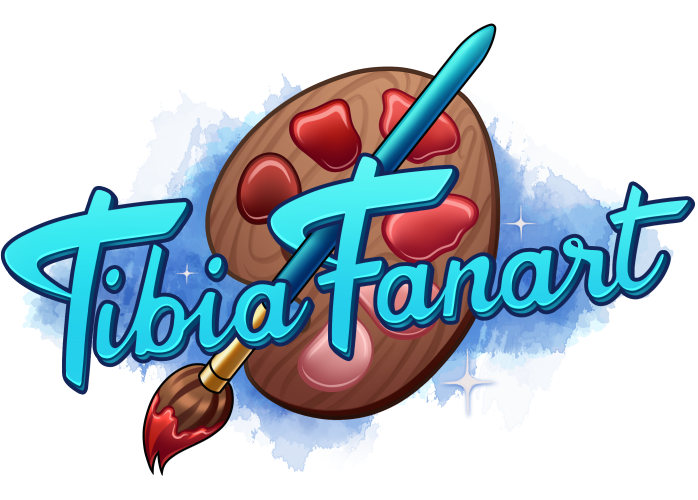Tibia is Made of Pixels
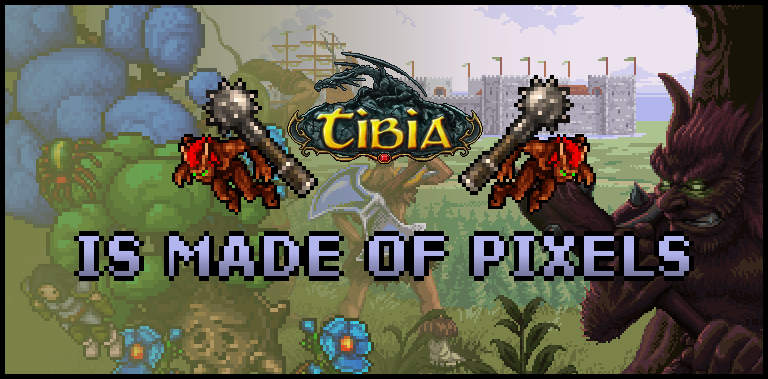
INTRO
One of Tibia’s most eye-catching characteristics is certainly its 2D pixel look. While new graphics have constantly been added and older ones have been revamped over the years, we have always stuck to Tibia’s roots and preserved its charming 2D pixel style over the years. With the rise of indie and mobile games, 2D pixel art has gained new fame in the gaming world, and many games are made to look and feel retro. So while many developers are deliberately going old school these days, Tibia does not need to mimic retro aesthetics for it has retained its look and feel for more than 16 years now. It survived the onslaught of 3D games by embracing its origins, and as such, is truly a veteran in the gaming world.
PIXEL ART IN A NUTSHELL
Video games have come a long way since the heyday of 8-bit systems in the 80’s and early 90’s. Back in the early days of 2D games, developers had to work with many restrictions. Because the hardware was not as powerful and advanced yet, game graphics were typically created by editing images on a pixel level, by arranging the smallest building blocks of a digital image so that they form a meaningful picture. Graphic designers often displayed great skills in their attempts to make the most out of limitations such as image resolution and the palette of available colours to use. So out of a necessity, minimalist pixel art emerged as a digital art form.
As the technology improved over time, 3D graphics became more common and popular, and pixel art was not “in vogue” anymore. Many started to consider it outdated and clunky. However, accompanied and nourished by a retro revival in popular culture, pixel art and chip music have seen an amazing resurgence in recent years. Besides the nostalgic appeal of pixel art, people have come to acknowledge and admire its aesthetics and its focus on control and precision.
Nowadays, though, working with restrictions when creating pixel art is a deliberate choice. There are no written rules that clearly define what is considered pixel art and what is not. People set their own rules and choose the limitations they want to pay attention to. Nevertheless, many pixel artists advocate a low colour count and a low resolution, and, of course, arranging pixels manually, and thus, purposefully.
While not each and every pixel needs to be placed manually, filters and tools that create blurring or smudging effects through automatic anti-aliasing, for example, are usually avoided. They blow up the colour count and interfere with the artist’s control of the image, the precise placement of pixels. Plainly speaking, the decision where to place a pixel is no longer made by the artist but by the computer.
TIBIA’S PIXEL GRAPHICS
The 2D approach of Tibia has always been a means to keep the hardware requirements for the game as low as possible, and thus, to ensure a good performance on a wide range of hardware and operating systems. Until today, Tibia’s tile-based engine with 2D sprites allows to reach an appealing and consistent visual quality through the use of easily modifiable graphics. When Tibia was created, reaching this goal was not entirely possible with the 3D technology at that time without making compromises or risking that the game would not age well.
The game world, or map, of Tibia consists of 2D tiles, a myriad of manually created 2D pixel graphics. So all these tiles are like puzzle pieces that fit together to form a larger picture. Creatures, player characters and other things such as items and the like are sprites, two-dimensional images that are often animated as well. But why does Tibia employ pixel art in the first place instead of painted images or animations, for example?
Lyxoph, one of Tibia’s graphic artists and a pixel wizard himself, mentions Tibia’s low resolution: “Every square in Tibia is 32 x 32 pixels. If you create graphics for such a low resolution, you want to make very efficient use of the little space you’ve got, thus making every pixel count. It is possible to use for example pre-rendered 3D graphics, vector art or painted images, and resize them to the dimensions required for Tibia with software algorithms. However, if you do that, you lose a lot of control over the details represented in the final sprites. Only pixel art makes it possible for an artist to define the placement of minutest details which are required to fill the sprites with life at this small size – one very obvious example for this are the outfit’s eyes, which literally consist of only one pixel. A lot of creatures on the other hand have eyes consisting of two pixels or more, which can totally change the character of any face and open up possibilities to depict that ‘evil stare’ a lot of Tibia creatures have.“
So are Tibia’s graphics pixel art? Strictly speaking and from a stylistic point of view, they are not 100% hardcore pixel art according to what pixel connoisseurs usually associate with the term. Lyxoph explains that “sometimes you just have to be pragmatic and choose whatever works best to achieve the look you’re aiming for and keeping deadlines in mind. For example, Tibia’s palette is not limited in any way, and we’re making use of that while still trying to make sure that new graphics match on a visual level and belong together.” Despite occasionally breaking some of the guidelines set by hardcore pixel artists, Tibia’s graphics still exhibit the crisp and clear look that is typical for pixel art. It best comes out if you do not stretch or shrink the game window, a setting that you can tick in the graphical options menu ingame. Until recently, stretching the game window always employed automatic anti-aliasing to smooth the jagged appearance of Tibia’s pixel graphics. However, automatic anti-aliasing also takes away the edges, and thus leads to a less chunky, but much more blurry or even smudgy appearance as you can easily see on the zoomed-in picture of a small Tibia item below.

The small ruby on the left side is shown in a pixel perfect way without anti-aliasing: you clearly see the individual pixels the ruby is made of which gives the image a crisp and clean feel and appearance. The ruby to the right appears to be different even though it is a screen capture of the very same ruby. The effect results from turning anti-aliasing on. Automatic anti-aliasing leads to a smoother but also much more blurry image and a considerably higher colour count. Furthermore, it darkens the image which you easily notice if you compare the white pixels on the left ruby to the shades of grey on the right ruby. There are no more true white pixels there. If you click on the ruby image, you can see a desaturated screenshot of Darashia which also exemplifies this effect. Pay attention to how the thorns of the cacti darken with anti-aliasing activated.
The same effects can be seen in the screenshot made in one of Tibia’s more recent areas where careful attention was paid to creating the graphics in a more true-to-typical-pixel-art-restrictions-style: Fiehonja, the Deepling area. Below, you can see how the area looks in its unaltered beauty – if you do not stretch or shrink the game window – which brings out the designers’ vision as best as possible. If you click on the image below you will see a comparison between a stretched game window without anti-aliasing activated and a stretched game window with anti-aliasing on. Obviously, turning anti-aliasing off comes closest to the original image.
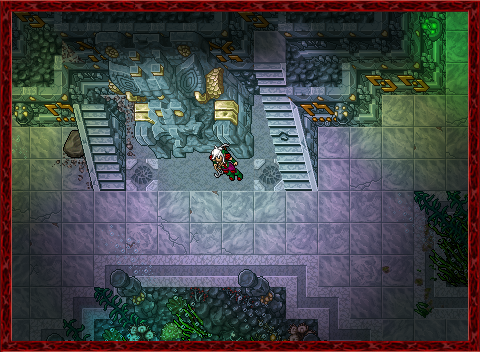
Lyxoph sums up why the option to turn anti-aliasing on/off was added to the game: “We included this option since we are trying to represent Tibia’s retro graphics the way they were meant to be. All graphics for the game are created with clean and crisp edges, keeping each and every pixel in mind. They are designed to look pixelated. If we didn’t care about keeping every pixel recognisable, we would have chosen an entirely different technique for representing ingame graphics in the first place, just not pixel art. We felt that the filtering of the graphics ingame hampered with our vision of what the game should look like. But of course, this is also a matter of taste and how you’re used to seeing the graphics over all the years. That’s why we left the option in to activate or deactivate anti-aliasing.“
THE MAKING OF PIXEL ART
While the only enforced restriction for Tibia is the low resolution, one thing that certainly adds another challenge is Tibia’s perspective. Pixel art is usually made by either using isometric projection to produce some kind of a three-dimensional effect, or by choosing a non-isometric perspective.
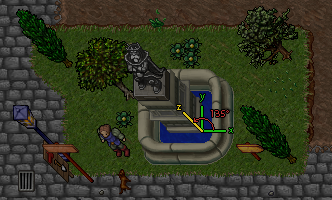
Lyxoph tells us that “if you’ve played other games and saw Tibia’s perspective for the first time, you’d probably be tempted to call it isometric.” He then goes on to explain unusual part about it: “However, Tibia actually uses a so-called oblique projection. The difference between an oblique projection and an isometric perspective is that in Tibia, everything that lies in parallel to the floor is viewed top-down and the angle between the x- and y-axis is 90°. The vertical z-axis however is angled at 135° in relation to the x-axis, which accounts for a distortion in that direction. In isometric perspectives however, the angles between all axes are equal, thus leading to equal dimensions for all sides of an object.“
Not all pixel graphics in Tibia strictly match this perspective, though. The graphic artists make use of their artistic freedom here to choose whatever works best to achieve the desired result.
One of the more recently added prominent pieces of pixel art is Tibia’s new login screen which was created by Lyxoph. In order to gain some insight into the making of pixel art, we asked him about his intentions and working steps behind this marvellous picture: “The login screen was supposed to convey a rather mundane event in the life of Tibian players: the return of a group of adventurers to the city of Thais. Obviously the image is taking some artistic liberties, but I was trying to imagine what it would really look like, standing there north of Thais and looking down towards the city. The illustration started out as a very rough thumbnail sketch on paper. The next step was to take the image to Photoshop and start blocking in the basic shapes of all the elements in the picture. I kept the image monochrome at this point to try and get a better feel for the composition and value scale. After all the elements have been blocked in, it’s time to start adding details and colour. I began with the characters, and then worked my way through the mid- and background, starting to fill in more detail by really getting down to the pixel level. I also started changing around things that still looked odd while including feedback I received from my colleagues. Sticking to pixel art tradition, I tried keeping the colour count low within my palette by reusing colours whenever possible. One such example is the green tone used in the grass our heroes are standing on. This colour was reused both in the hunter’s cape and the dragon circling above. This, together with a shift towards warmer colours in the image in general, helped keeping the palette unified.“
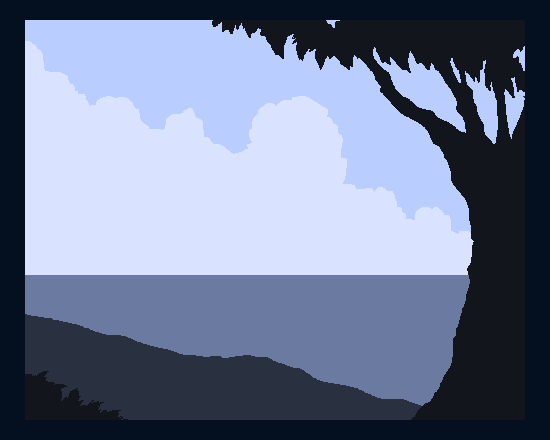
“I also started adding manual anti-aliasing to very harsh borders, like for example the outline of the tree and characters. This technique blends two adjacent colours by the placement of pixels of intermediate values between the two colours one is trying to blend. Towards the end, I realized there was still something missing in the illustration. The picture did not yet tell too much of a story, and there was this very empty spot in the bottom right corner. Thus I added a troll champion about to ambush our heroes (and probably get a serious pounding). After some final touch-ups mainly in the foreground the artwork was ready to be included in the client.“
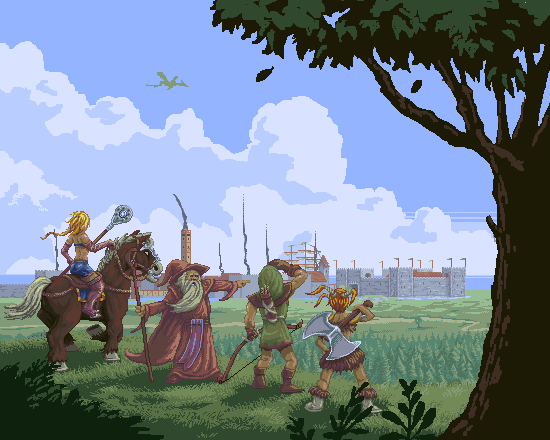
CONCLUSION
Ultimately, it is still a matter of taste if you prefer 2D pixel art or rather dig 3D graphics. However, we hope that our featured article helped to illustrate that there are many reasons to appreciate pixel art, or at least to regard Tibia’s pixel graphics as a stylistic choice that suits the game and conveys a message, instead of downgrading them to something unimportant that does not hold any meaning.
Pixel art is a rather timeless art style that does not chase latest technology trends. It has a classic look that does not aim for realism but rather focuses on abstraction. While it often clearly communicates the purpose of a picture, it also encourages you to use your imagination to fill in the gaps between the image and reality. This kind of personal investment helps to create an immersive game experience.
We strongly feel that the iconic 2D pixel look of Tibia is worthy of being cherished as something very valuable, an integral part of the game that brings out its heart and soul by igniting the imagination of all heroes and adventurers who set foot in this fantasy world. It is not a weakness to frown upon; it is a strength we are proud of. And yes, this is a declaration of love. <3
Every pixel counts!
Your Community Managers
The whole article was originally written by Community Managers and published on Nov 07 2013 on the official Tibia website. You can find it here:
